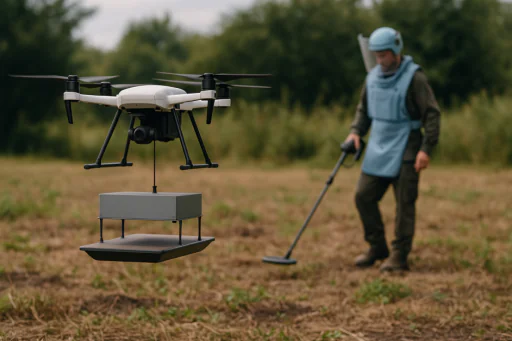
I’ve been working with drones since 2014, but the outbreak of war in Ukraine marked a turning point in my career. Since 2022, my focus has shifted to exploring how drones can be used to automate humanitarian demining – what capabilities they need, and how technology can make these efforts safer and more efficient. As part of this work, I closely follow the Geneva International Centre for Humanitarian Demining (GICHD), attend their events, and regularly engage with their experts.
Considering drone-based solutions paired with AI, they are actually helpful only at the non-technical survey (NTS) stage of the humanitarian demining process. It means drones scan large areas and collect data. Then, a machine learning model analyzes this data to flag regions that might contain mines. Not the exact places of mines.
Technical survey (TS), which confirms and maps contaminated areas, still relies on personnel with metal detectors, trained dogs, and mechanical demining machines. They go into the mined area to pinpoint the exact locations of the hazards.
The process keeps being long, risky, and expensive:
- In 2023, there were 15 casualties among deminers in three countries
- At the current speed, clearing all ERW will take over 100 years
- The cost of removing a single landmine is 50 to 100 times the cost of producing one
Mines also continue to be a threat to civilians – there were at least 5,757 mines/ERW casualties in 2023.
In this post, I explain why current drone-based solutions don’t work for technical survey (the most expensive and time-consuming stage right now) and share what I see as the best way to fix that.
Detecting mines under soil or vegetation is nearly impossible
Drones with standard optical or thermal cameras usually capture images from a single downward-facing angle. This approach works well for spotting surface-level anomalies but fails to detect buried or hidden mines. For this reason, drones are mostly used for non-technical surveys in humanitarian demining.
One of the frontline solutions – Safe Pro AI – reports that they have only a 5 percent detection rate in regions with trees and bushes.
Even though it is less relevant to Ukraine, where most mines are scattered on the ground, instead of buried, the situation is very different (for example) for Cambodia:
- 4-6 million landmines remain from conflicts in the 1970s-90s
- 64,000+ casualties since 1979, with children as primary victims
Non-metal and old metal mines are harder to detect, even on the surface
Non-metal mines present a significant portion of landmines in current and former conflict zones. They are intentionally designed to bypass detection by conventional metal detectors.
Visually, non-metallic mines are hard to detect. They don’t shine, stand out in images, or show up well on thermal cameras. Metal detectors and magnetometers either miss them or trigger too many false alarms.
So, current drone-based detection tools often miss non-metallic mines entirely.
When it comes to old metal mines, corrosion changes how they look and behave, so they blend into the ground and respond poorly to detection tools. Misshapen ones are even harder to identify in images.
And because these mines are more difficult to spot, they take much longer to find and remove, or they stay hidden and put both deminers and civilians at risk.
Weather and daytime dependency
If we are talking about drones with RGB and multispectral cameras, they require daylight. In cloudy, low-light, or shaded areas (forests, ruins), image quality and object detection drop too.
Thermal detection, in its turn, works best at dawn or dusk, when the ground and mine differ in temperature. During midday, the sun heats everything equally, reducing contrast.
While rain and wet soil blur surface detail, alter soil color and temperature, and can hide soil disturbance or thermal anomalies. Snow just covers visual markers and equalizes surface temperature, making mines undetectable.
Flying drones only at certain times considerably slows down even the NTS stage of demining, especially in areas with unpredictable weather.
The technology is very expensive
In 7 affected countries estimated antipersonnel mine contamination area reaches over 100km².
According to tests in Ukraine, demining with the new tech can cut costs from $3000-5000 to $600-800 per hectare, which is still $70,000 per square kilometer. And in some areas, it may well exceed the land price itself.
The main reason for the high costs is the multiple false alarms treated as real threats. On average, a team clears over 50 suspected mines to find just one actual landmine.
Most heavily contaminated areas are in developing countries. They can’t afford demining without funding from international organizations or governments.
The costs are also too high for businesses to jump in. Once demining becomes cheap enough, companies might lease mine-contaminated land on the condition that they clear it. In return, they’d get long-term use for a symbolic price and some tax breaks.
A solution?
With my team, we explored methods that gather more data, can see through foliage and soil, and still maintain sufficient resolution.
An example of a promising development direction is a project by researchers at the University of Oviedo. They’re testing an array-based ground-penetrating synthetic aperture radar (GPR-SAR) system mounted on a UAV.
Their in-flight validation in realistic scenarios proved that the technology solves the following problems:
1) The radar pinpoints the mine’s location with precision, leaving only the disarming or destruction to be done manually.
With the use of all possible radar paths (fully multistatic configuration), they got high-resolution images where buried targets appeared brighter and clearer. And were able to detect with precision challenging targets such as small, nonmetallic, and shallowly buried objects like plastic anti-personnel landmines, wooden pressure plates, and PVC pipes.
2) The solution can work day or night, in varied weather, and even with moderate vegetation.
How it works:
- Sends radar pulses into the ground.
- Detects reflections from subsurface changes (e.g., plastic, metal, voids).
- Builds 3D subsurface images with centimeter-level accuracy by combining radar signals from multiple transmitter-receiver (Tx- Rx) pairs and flight positions.
The solution still has its limitations, but based on my background, it is the most relevant direction of research and development right now.
One of GPR’s main strengths is how much data it can collect. More data means researchers can improve accuracy at the recognition/classification stage with AI. This leads to more efficient survey and clearance work and cuts overall costs by 50% or more.
The post Beyond Drones and AI: Rethinking the Future of Humanitarian Demining appeared first on Unite.AI.


